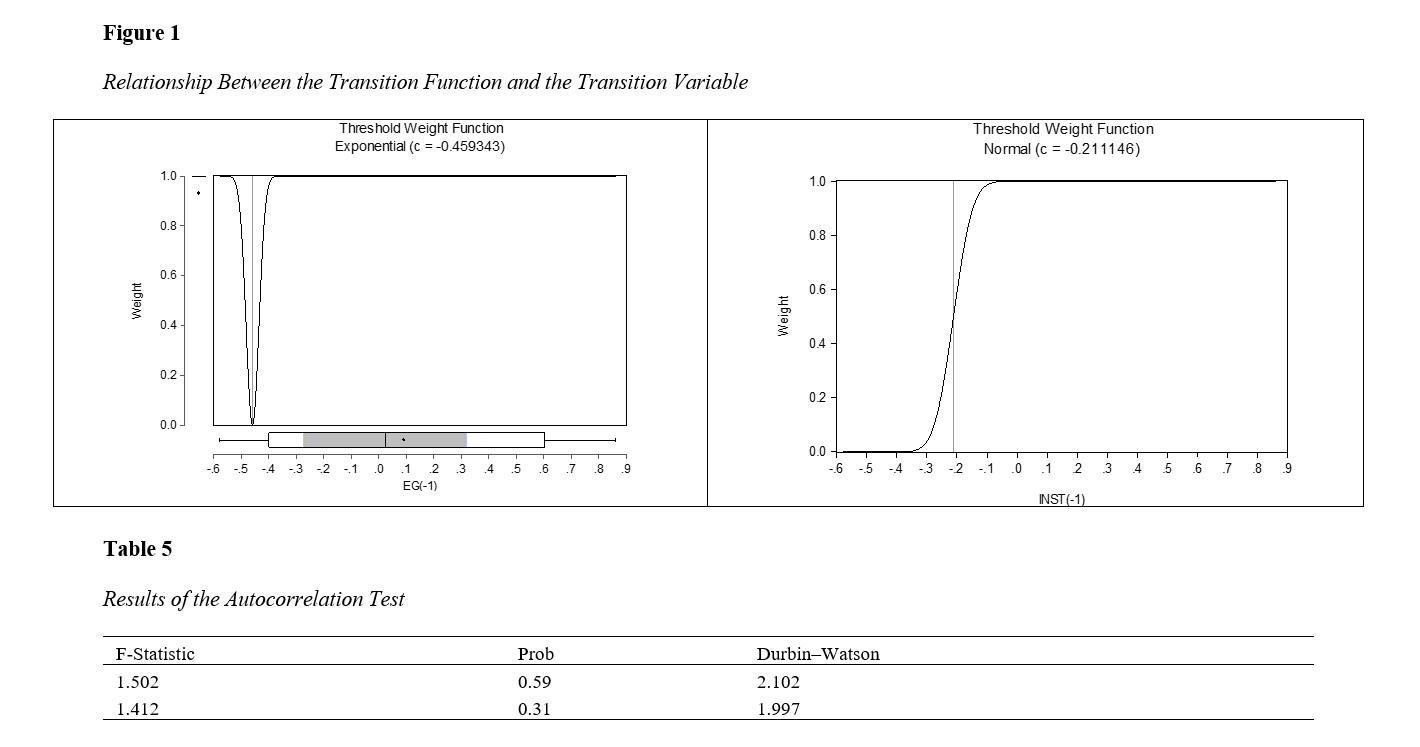Examining the Threshold Effects of Government Governance on the Relationship Between Globalization, Government Effectiveness, and Environmental Pollutant Quality in Selected Developing Countries
Keywords:
Government governance, globalization, government effectiveness, environmental pollutants, selected developing countriesAbstract
Given the significance of the topic and the undeniable role of the environment in human life, this study seeks to examine the threshold effects of government governance on the relationship between globalization, government effectiveness, and the quality of environmental pollutants in selected developing countries during the period 2005 to 2023, using the Panel Smooth Transition Regression (PSTR) model. The research sample includes selected MENA and Middle Eastern countries, namely Saudi Arabia, Qatar, Pakistan, the United Arab Emirates, Algeria, Kuwait, Iran, Egypt, Oman, Morocco, Libya, Yemen, and Sudan. The findings reveal that by employing a PSTR model in which the transition variable is trade volume (EG) in the first model and government governance (INST) in the second model, the functional relationship between economic globalization and environmental quality can be modeled. The estimated results for the linear part of the first and second models (Regime 1) indicate that trade volume (EG) and gross domestic product (GDP) have a positive relationship with nitrogen dioxide (NO₂) emissions. Specifically, a one-unit increase in trade volume and GDP leads to an increase of 0.21 and 0.22 units in greenhouse gas emissions, respectively, in the first model. Furthermore, the variable of governance quality (INST) in the second model results in a reduction of 0.12 units in nitrogen dioxide (NO₂) emissions, and the interaction term of government governance with trade volume (INST × EG) reduces NO₂ emissions by 0.11 units. Additionally, the estimated results for the nonlinear part of the first and second models (Regime 2) confirm the presence of a positive relationship between trade volume (EG) and gross domestic product (GDP) with nitrogen dioxide (NO₂) emissions.
References
Abbas, Y. A., Mehmood, W., Lazim, Y. Y., & Aman-Ullah, A. (2022). Sustainability reporting and corporate reputation of Malaysian IPO companies. Environmental Science and Pollution Research, 29, 78726-78738. https://doi.org/10.1007/S11356-022-21320-9
Ahmad, N., Youjin, L., Zikovi, S., & Belyaeva, Z. (2023). The effects of technological innovation on sustainable development and environmental degradation: evidence from China. Technology in Society, 72. https://doi.org/10.1016/J.TECHSOC.2022.102184
Awosusi, A. A., Saint Akadiri, S., Olanrewaju, V. O., Rjoub, H., Ozdeser, H., & Ojekemi, O. (2023). The role of energy, political stability, and real income on achieving carbon neutrality: asymmetric evidence. Environmental Science and Pollution Research, 1, 1-17. https://doi.org/10.1007/s11356-023-28136-1
Azimi, M. N., Rahman, M. M., & Nghiem, S. (2023). Linking governance with environmental quality: a global perspective. https://doi.org/10.1038/s41598-023-42221-y
Bacchetta, M., Bekkers, E., Solleder, J., & Tresa, E. (2022). Environmental Goods Trade Liberalization: A Quantitative Modelling Study of Trade and Emission Effects. https://publication.aercafricalibrary.org/handle/123456789/1150
Balogh, J. M., & Borges Aguiar, G. M. (2022). Determinants of Latin American and the Caribbean agricultural trade: A gravity model approach. Agricultural Economics - Czech, 68, 127-136. https://doi.org/10.17221/405/2021-AGRICECON
Baqerian Kasgari, B. (2023). The impact of regulations on the export of environmental goods in Iran. Journal of Business Research(107), 235-211. https://ecor.modares.ac.ir/browse.php?a_code=A-10-54572-2&slc_lang=fa&sid=18
Doan, T. N., & Ha, L. T. (2022). Is religiosity distance a driver of trade in environmental goods? Applied Economics Letters. https://doi.org/10.1080/13504851.2022.2083058
Fuinhas, J. A., Koengkan, M., Filipe, R., Santiago, B., Madaleno, M., & Nogueira, M. C. (2023). How renewable energy and CO2 emissions contribute to economic growth, and sustainability-an extensive analysis. Sustainability Times, 15, 4089. https://doi.org/10.3390/SU15054089
Huang, J., & Wu, Z. (2022). Impact of Environmental Regulations on Export Trade -Empirical Analysis Based on Zhejiang Province. International journal of environmental research and public health, 19, 3-14. https://doi.org/10.3390/ijerph191912569
Kirikkaleli, D., & Osmanlı, A. (2023). The Impact of Political Stability on Environmental Quality in the Long Run: The Case of Turkey. Sustainability, 15, 9056. https://doi.org/10.3390/su15119056
Kohli, D. (2022). Environmental Regulation and Intra-Industry Trade: An Empirical Analysis. The International Trade Journal, 36(5), 377-399. https://doi.org/10.1080/08853908.2021.1952122
Li, J., Dong, K., Wang, K., & Dong, X. (2023). How does natural resource dependence influence carbon emissions? The role of environmental regulation. Resources Policy, 80, 103268. https://doi.org/10.1016/J.RESOURPOL.2022.103268
Lu, R., Yang, Y., Liu, J., & Ayub, A. (2024). Exploring the impact of financial globalization, good governance and renewable energy consumption on environmental pollution: Evidence from BRICS-T countries. Heliyon, 10, e33398. https://doi.org/10.1016/j.heliyon.2024.e33398
Luo, J., Zhuo, W., & Xu, B. (2023). The bigger, the better? Optimal NGO size of human resources and governance quality of entrepreneurship in circular economy. Management Decision. https://doi.org/10.1108/MD-03-2023-0325
Nemati, B., Karimi, F., & Daei Karimzadeh, S. (2023). Institutional constraints and their impact on the export of environmental goods in developing countries. Scientific Journal of Economic Research: Growth and Sustainable Development, 23(4), 47-25. https://ecor.modares.ac.ir/article-18-66517-fa.html
Nikkhah Serneghi, A., & Karim, D. K. S. (2022). The relationship between economic growth, trade openness, and carbon dioxide emissions in developed countries. Scientific Research on Economic Growth and Development, 13(49), 106-191. https://egdr.journals.pnu.ac.ir/article_8172.html
Oteng, J., Zuo, E., & Sharifi, E. (2023). An evaluation of the impact framework for product stewardship on end-of-life solar photovoltaic modules: an environmental lifecycle assessment. Journal of Cleaner Production, 411. https://doi.org/10.1016/J.JCLEPRO.2023.137357
Rosser. (2022). Higher education in Indonesia: the political economy of institution-level governance.
Shahin, A., Polonsky, M. J., Wood, L. C., Presbitero, A., & Wijayasundara, M. (2024). Greening the Procurement: A SMART Evaluation of Environmental Sustainability In Australian Government Purchasing Policies. Asia Pacific Journal of Marketing and Logistics. https://doi.org/10.1108/apjml-03-2024-0350
Sheikh, I. H. (2023). Impact of economic growth, energy use and research and development expenditure on carbon emissions: an analysis of 29 OECD countries. International Journal of Energy Economics and Policy, 13, 454-464. https://doi.org/10.32479/ijeep.13647
Tan, J., Hua, M., & Chan, K. C. (2024). Do anticipated government environmental audits improve firm productivity? Evidence from China. Finance Research Letters, 61, 104985. https://doi.org/10.1016/j.frl.2024.104985
Udemba, N., Khan, S. A., & Raza Shah, S. (2024). Demographic change effect on ecological footprint: a tripartite study of urbanization, aging population, and environmental mitigation technology. Journal of Cleaner Production, 437. https://doi.org/10.1016/J.JCLEPRO.2023.140406
Wan, L., Zheng, H., & Kong, D. (2025). Methodological Innovation in Government Environmental Auditing Through Biomechanical Principles: An Approach to Environmental Impact Performance Evaluation. Molecular & Cellular Biomechanics, 22(4), 1704. https://doi.org/10.62617/mcb1704
Wan, Q., Miao, X., & Afshan, S. (2022). Dynamic effects of natural resource abundance, green financing, and government environmental concerns toward the sustainable environment in China. Resources Policy, 79, 102954. https://doi.org/10.1016/J.RESOURPOL.2022.102954
Wang, G., Peng, Y., Luo, H., & Du, H. (2023). Asymmetric influence of renewable energy, ecological governance, and human development on green growth of BRICS countries. Renewable Energy, 206, 1007-1019. https://doi.org/10.1016/J.RENENE.2022.12.125
Wang, K., Rehman, M. A., Fahad, S., & Linzhao, Z. (2023). Unleashing the influence of natural resources, sustainable energy and human capital on consumption-based carbon emissions in G-7 Countries. Resources Policy, 81, 103384. https://doi.org/10.1016/J.RESOURPOL.2023.103384
Yasmeen, R., Hao, G., Ye, Y., Hassan Shah, W. U., & Kamal, M. A. (2023). The role of governance quality on mobilizing environmental technology and environmental taxations for renewable energy and ecological sustainability in belt and road economies: A methods of Moment's quantile regression. Energy Strategy Reviews, 50, 101258. https://doi.org/10.1016/j.esr.2023.101258
Zhao, K., Wang, X., Dong, K., & Dong, X. (2022). Is smart transportation associated with reduced carbon emissions? The case of China. Energy Economics, 105, 105715. https://doi.org/10.1016/j.eneco.2021.105715
Zheng, Y., Wu, Y., Lin, Y., & Zheng, Y. (2023). Coordination evaluation of urban tourism and urban development based on TOPSIS method-a case of Xiamen city. Environmental Science and Pollution Research. https://doi.org/10.1007/S11356-023-26088-0

Downloads
Published
Submitted
Revised
Accepted
Issue
Section
License
Copyright (c) 2025 Mohamadamin Talebi (Author); Mahnaz Rabiei; Fatemeh Zandi, Mohammad Khezri (Author)

This work is licensed under a Creative Commons Attribution-NonCommercial 4.0 International License.









